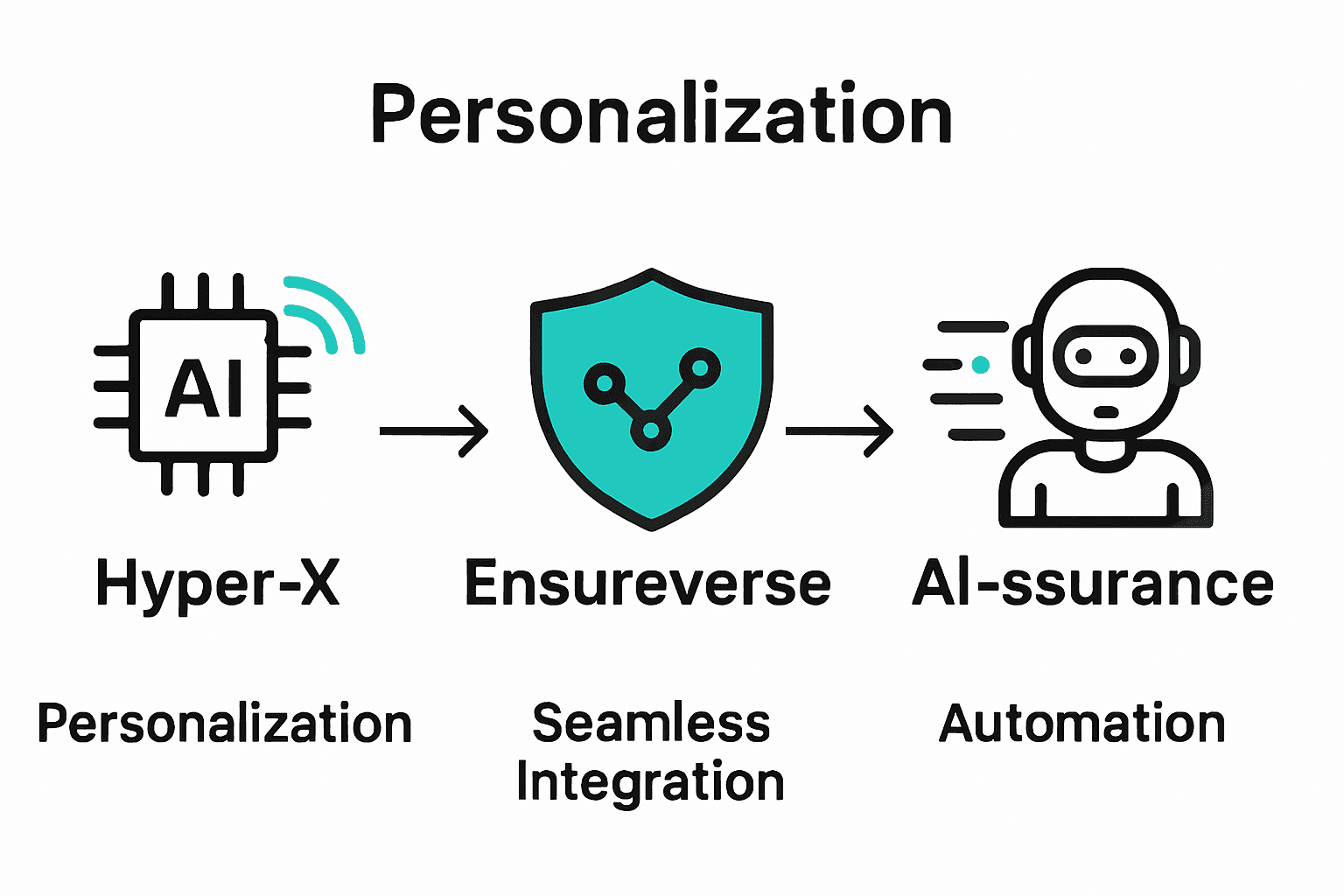15.10.25

Nearly 70 percent of insurance customers now expect instant quotes, digital policies, and real-time support from their providers. This shift is pushing insurers to rethink every step of the customer journey. As technology grows smarter and regulations get tighter, the insurance industry faces both new challenges and huge opportunities for those ready to adapt. Understanding these changes is crucial for anyone seeking better coverage and peace of mind in a rapidly evolving digital world.
Key Takeaways
| Point | Details |
|---|---|
| Transformation of Insurance | By 2025, digital insurance will focus on personalized, proactive platforms integrating technology with human expertise. |
| Technological Paradigms | Key innovations like Hyper-X, Ensureverse, and AI-ssurance will enhance personalization, automation, and seamless integration of insurance services. |
| Omnichannel Engagement | A hybrid engagement model will emerge, blending online self-service with human support to cater to varying consumer needs. |
| Regulatory Compliance | Insurers must adapt to new AI governance and cybersecurity standards, viewing compliance as a means to build trust and enhance technology capabilities. |
Table of Contents
- Defining Digital Insurance In 2025
- Key Technology Innovations Transforming Insurance
- Evolving Distribution And Engagement Models
- Regulatory Trends And Compliance Issues
- Strategic Priorities And Industry Challenges
Defining Digital Insurance in 2025
Digital insurance in 2025 represents far more than just online policy purchases. It’s a comprehensive transformation of how insurance products are designed, distributed, and experienced by consumers. Digital insurance now encompasses intelligent, personalized platforms that leverage advanced technologies to create seamless, customer-centric interactions.
According to research from an empirical academic study in Poland, the emerging digital insurance model is characterized by a strategic hybrid approach. This approach combines digital convenience with human expertise, recognizing that consumers value both technological efficiency and personalized guidance. Key characteristics include:
- Speed: Instant quote generation and policy issuance
- Transparency: Clear, accessible policy information
- Customization: AI-driven personalized insurance products
- Hybrid Service: Integrated digital tools with human agent support
The study highlights critical adoption drivers for digital insurance: trust and usability. Consumers are no longer satisfied with traditional, paper-heavy insurance experiences. They demand intuitive interfaces, real-time communication, and solutions that adapt to their unique risk profiles.
 Read more about digital-first insurance strategies to understand how insurers are meeting these evolving expectations.
Read more about digital-first insurance strategies to understand how insurers are meeting these evolving expectations.
Technology is reshaping insurance from a transactional service into a proactive, data-driven relationship. By 2025, successful digital insurance platforms will not just sell policies, but provide comprehensive risk management experiences that anticipate customer needs before they arise.
Key Technology Innovations Transforming Insurance
Technology is radically reshaping the insurance landscape in 2025, with groundbreaking innovations that go far beyond traditional risk assessment and claims processing. Hyper-personalization and intelligent automation are driving a new era of customer-centric insurance solutions.
According to NTT DATA’s Insurtech Global Outlook 2025, three transformative technological paradigms are emerging:
- Hyper-X: AI-driven personalization leveraging IoT and synthetic data
- Ensureverse: Embedded, always-on insurance experiences
- AI-ssurance: Advanced generative AI reshaping underwriting and claims processes
The Hyper-X concept represents a quantum leap in personalized insurance. By integrating artificial intelligence with Internet of Things (IoT) sensors and synthetic data generation, insurers can now create hyperspecific risk profiles. This means insurance products that adapt in real-time to an individual’s behavior, environment, and changing life circumstances. Learn more about opportunities for P&C insurers embracing insurtech.
Here’s a comparison of the three transformative insurance technology paradigms in 2025:
| Paradigm | Core Technologies | Customer Advantage |
|---|---|---|
| Hyper-X | AI & IoT Synthetic Data |
Real-time personalization Adaptive product design |
| Ensureverse | Embedded Systems Always-on Platforms |
Seamless integration Continuous protection |
| AI-ssurance | Generative AI Advanced ML Algorithms |
Enhanced underwriting Automated claims processing |
Generative AI is particularly transformative in the AI-ssurance model.
 Machine learning algorithms can now predict risk scenarios with unprecedented accuracy, automate complex claims processing, and generate dynamic underwriting models. This technological evolution means faster claims resolution, more accurate pricing, and a dramatically improved customer experience that anticipates needs before they become critical problems.
Machine learning algorithms can now predict risk scenarios with unprecedented accuracy, automate complex claims processing, and generate dynamic underwriting models. This technological evolution means faster claims resolution, more accurate pricing, and a dramatically improved customer experience that anticipates needs before they become critical problems.
Evolving Distribution and Engagement Models
The insurance distribution landscape is undergoing a fundamental transformation, moving beyond traditional single-channel approaches to sophisticated omnichannel strategies. Consumers now expect seamless, integrated experiences that combine digital convenience with personalized human support.
Research from a comprehensive academic study in Poland reveals a nuanced consumer preference that challenges previous assumptions about digital insurance adoption. The findings highlight a strategic hybrid engagement model where:
- Simple insurance products are increasingly purchased through online channels
- Complex insurance decisions still rely on human agent expertise
- Digital tools and traditional agents coexist, complementing each other
This emerging model recognizes that different insurance products require different levels of interaction. Explore our guide on digital transformation strategies to understand how insurers are adapting to these evolving consumer expectations.
The key to successful distribution in 2025 is flexibility. Insurers must develop platforms that seamlessly transition between digital self-service tools and personalized agent interactions. By creating intelligent, context-aware engagement models, insurance companies can meet diverse customer preferences, providing the right level of support at exactly the right moment in the customer journey.
Regulatory Trends and Compliance Issues
The digital insurance landscape in 2025 is being dramatically reshaped by complex regulatory frameworks that prioritize technological accountability, data protection, and operational resilience. Artificial intelligence governance and cybersecurity standards have become central focus areas for insurers navigating an increasingly regulated environment.
The EU’s Artificial Intelligence Act (Regulation (EU) 2024/1689) introduces groundbreaking risk-based regulations that will fundamentally transform how insurers deploy AI technologies. Key provisions include:
- Mandatory risk assessments for AI systems
- Strict transparency requirements
- Graduated compliance frameworks based on AI application risks
- Enforceable rules becoming active by August 2, 2025
Embracing compliance through next-generation insurance platforms has become critical. Additionally, the EU’s Digital Operational Resilience Act (DORA) introduces comprehensive cybersecurity mandates, requiring financial entities including insurers to develop robust digital operational resilience strategies.
These regulatory developments signal a profound shift. Insurers must now view compliance not as a burden, but as a strategic opportunity to build trust, enhance technological capabilities, and demonstrate commitment to ethical digital innovation. The most successful organizations will be those that proactively integrate regulatory requirements into their core technological and operational design.
Strategic Priorities and Industry Challenges
The insurance industry stands at a critical crossroads in 2025, balancing unprecedented technological opportunities with complex ethical and operational challenges. Digital transformation is no longer optional but a fundamental survival strategy for insurers seeking to remain competitive.
According to a professional report, AI-focused insurtech financing has experienced a remarkable surge, bringing both significant benefits and potential risks. The key strategic priorities and challenges include:
- Automation Potential: Enhanced operational efficiency through AI
- Pricing Optimization: More accurate risk assessment and dynamic pricing
- Emerging Risks: Challenges like deepfake fraud and algorithmic bias
- Ethical Considerations: Preventing customer exclusion through automated systems
Learn more about the top challenges facing the insurance industry, insurers must develop sophisticated strategies that balance technological innovation with robust risk management. The most successful organizations will be those that can navigate these complex dynamics, creating adaptive systems that leverage AI’s power while maintaining strict ethical standards and customer trust.
Ultimately, the strategic priority is building resilient, intelligent insurance ecosystems that can rapidly evolve, protect against emerging risks, and deliver personalized value to customers in an increasingly complex digital landscape.
Ready to Transform Your Insurance Business for 2025?
Is your organization feeling the pressure to keep up with the rapid changes in digital insurance? The article highlights the need for seamless digital transformation, robust regulatory compliance, and true omnichannel customer experiences. Many insurers now struggle with outdated systems, slow product launches, and the complex demands of hyper-personalization and AI-driven operations.
You do not have to face these challenges alone. Insurance Business Applications (IBA) supports property and casualty insurers through every stage of the digital journey. IBSuite is a cloud-native, API-first platform that enables you to accelerate product innovation, simplify compliance, and empower both customers and agents with intuitive, hybrid service models. With features tailored for the evolving insurance landscape—like instant policy issuance, real-time risk management, and effortless integration—IBSuite prepares you for the future of insurance.
Take the next step now. See how IBSuite can help you stay ahead of the 2025 trends. Get a personalized demo today and discover how our modern insurance platform can streamline your transformation. Explore more about digital-first insurance strategies and digital transformation tools designed for growth. The future of insurance starts with you.
Frequently Asked Questions
What is digital insurance in 2025?
Digital insurance in 2025 refers to a comprehensive transformation involving intelligent, personalized platforms that enhance how insurance products are designed, distributed, and experienced by consumers, moving beyond just online policy purchases.
What are the key characteristics of digital insurance?
The key characteristics of digital insurance include speed with instant quote generation, transparency in policy information, customization through AI-driven products, and hybrid service combining digital tools with human agent support.
How is technology transforming the insurance industry?
Technology is reshaping the insurance industry through innovations like hyper-personalization, embedded insurance experiences, and advanced generative AI, which improve underwriting, claims processing, and overall customer experience.
What regulatory trends should insurers be aware of in 2025?
Insurers should focus on regulations like the EU’s Artificial Intelligence Act, which mandates risk assessments and transparency for AI systems, and the Digital Operational Resilience Act, requiring robust cybersecurity strategies.
Recommended
- Insurance Digital Transformation Guide for Effective Change – Digital Insurance Platform | IBSuite Insurance Software | Modern Insurance System
- Understanding Digital-First Insurance Strategies – Digital Insurance Platform | IBSuite Insurance Software | Modern Insurance System
- Understanding Digital Maturity in Insurance Landscape – Digital Insurance Platform | IBSuite Insurance Software | Modern Insurance System
- Enhancing Customer Experience with Digital Transformation – Digital Insurance Platform | IBSuite Insurance Software | Modern Insurance System
- Top Digital Marketing Techniques for 2025: A Complete Guide